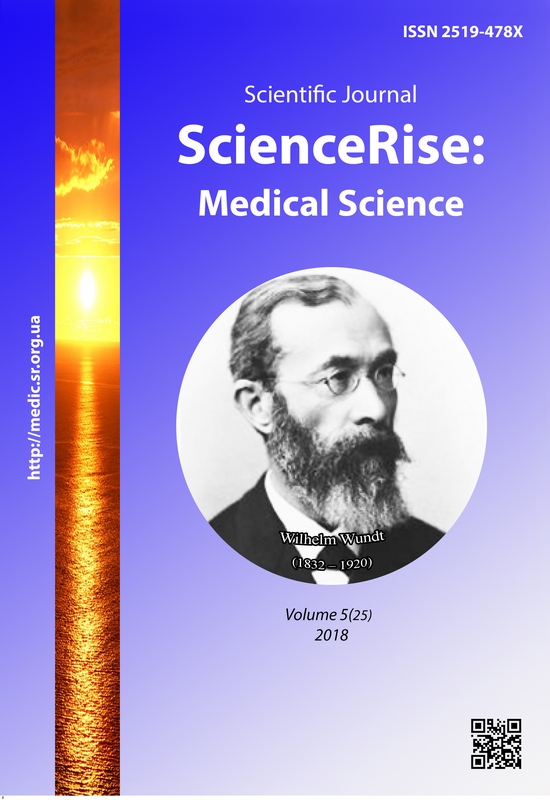Results of surgical treatment of pericardial effusion using minimally invasive interventions
DOI:
https://doi.org/10.15587/2519-4798.2018.139623Keywords:
pericarditis, pericardial effusion, pericardiotomy, thoracoscopy, pericardioscopy, minimally invasive, surgical treatmentAbstract
Pericardial effusion is the most common pathology of the pericardium and has a diverse etiology. In case of ineffective conservative therapy and recurrent disease, surgical treatment became the method of choice. Many interventions have been proposed for the treatment of pericardial effusion, but there is no systematic approach to the choice and capacity of the surgical treatment, that can improve the effectiveness of treatment and reduce the rehabilitation period.
Aim of the study. Evaluate the results of surgical treatment of pericardial effusion using minimally invasive interventions and compare it with others proposed for now.
Materials and methods. We present the results of surgical treatment of 171 patients with pericardial effusion, treated at the ST “Zaycev V.T. Institute of General and Urgent Surgery AMS of Ukraine” from 2000 to 2017. The immediate and long-term results and the duration of the rehabilitation period are estimated.
Results. In the period of using the systemic and differentiated approach to surgical treatment, 77 patients were operated. The level of postoperative complications was 2.60% - acute right ventricular failure in 1 (1.30%) patient, pneumothorax on the side of intervention in 1 (1.30%) patient. The level of postoperative mortality was 1.30% (1 patient with acute right ventricular failure in the early postoperative period). The average number of total bed-days was 9.2 ± 2.3 days, postoperative days-days – 5.3 ± 2.0 days. The statistical difference in the number of recurrent cases, depending on the type and extent of the intervention, was not established.
Conclusions. Using a differentiated approach to the choice of tactics and the capacity of surgical interventions can reliably reduce the number of postoperative complications and level of mortality. The use of mini-invasive interventions reduces the duration of the period of treatment and rehabilitation.
References
- Arutyunov, G. P. (2006). Perikardit. Sovremennye problemy diagnostiki i lecheniya [Pericarditis. Modern problems of diagnosis and treatment]. Heart, 8, 384–400.
- Rumbesht, V. V., Diuzhikov, A. A., Kislitskii, A. I., Mozhaev, I. V., Galin, V. A., Mozhaev, N. N. et. al. (2008). Vozmozhnosti differentsialnoy diagnostiki perikarditov neyasnogo proishozhdeniya [Differential diagnostics possibilities for pericarditis with unclear genesis]. Cardiology and Cardiovascular Surgery, 6, 64–66.
- Giryalevskii, S. R. (2004). Diagnostika i lechenie zabolevanij perikarda: sovremennye podhody, osnovannye na dokazatelnoi informacii i klinicheskom opyte [Diagnosis and treatment of pericardial diseases: modern approaches based on evidence and clinical experience]. Moscow: Media Sfera, 132.
- Haponiuk, I., Kwasniak, E., Chojnicki, M., Jaworski, R., Steffens, M., Sendrowska, A. et. al. (2015). Minimally invasive transxiphoid approach for management of pediatric cardiac tamponade – one center’s experience. Videosurgery and Other Miniinvasive Techniques, 10 (1), 107–114. doi: http://doi.org/10.5114/wiitm.2014.47690
- Liberman, M., Labos, C., Friedberg, J. S., Sheiner, N. M., Mulder, D. C. (2005). Ten-year experience with nontraumatic pericardial effusion: a comparison between the subxyphoid and transthoracic approaches to pericardial window. Archives of Surgery, 2005, 140 (2), 191–195. doi: http://doi.org/10.1001/archsurg.140.2.191
- Ponikowski, P., Voors, A. A., Anker, S. D., Bueno, H., Cleland, J. G. F., Coats, A. J. S. et. al. (2016). 2016 ESC Guidelines for the diagnosis and treatment of acute and chronic heart failure. European Heart Journal, 37 (27), 2129–2200. doi: http://doi.org/10.1093/eurheartj/ehw128
- Uramoto, H., Hanagiri, T. (2010). Video-assisted thoracoscopic pericardiectomy for malignant pericardial effusion. Anticancer research, 30, 4691–4694.
- Celik, S., Celik, M., Aydemir, B., Tanrıkulu, H., Okay, T., Tanrikulu, N. (2012). Surgical properties and survival of a pericardial window via left minithoracotomy for benign and malignant pericardial tamponade in cancer patients. World Journal of Surgical Oncology, 10 (1), 123. doi: http://doi.org/10.1186/1477-7819-10-123
- Tudoran, C., Tudoran, M., Avram, R., Balas, M., Vlad, M., Zosin, I. (2011). Particularities of pericardial effusion in patients with hypothyroidism. Journal of Experimental Medicine & Surgical Research, 4, 176–179.
- Kimura, T., Miyoshi, S., Okamoto, K., Fukumoto, K., Tanimoto, K., Soejima, K. et. al. (2012). The effectiveness of rigid pericardial endoscopy for minimally invasive minor surgeries: cell transplantation, epicardial pacemaker lead implantation, and epicardial ablation. Journal of Cardiothoracic Surgery, 7 (1). doi: http://doi.org/10.1186/1749-8090-7-117
- Matijevic, D. N. (2015). Haemodynamic Monitoring of Pericardial Effusion with Cardiac Tamponade in a Patient with Colorectal Cancer. Journal of Anesthesia & Critical Care: Open Access, 2 (4), 61–62. doi: http://doi.org/10.15406/jaccoa.2015.02.00061
- Ursol, G. M., Kolyesov, Ye. V., Veligockii, M. M. (2013). Perikardioskopiya [Pericardioscopy]. Clinical Anatomy and Operative Surgery, 12 (3), 75–79.
- Petcu, C. P., Dilof, R., Bataios, C., Pectu, P. D. (2013). Purulent pericardial effusions with pericardial tamponade – diagnosis and treatment issues. Current Health Sciences Journal, 39 (1), 53–56.
Downloads
Published
How to Cite
Issue
Section
License
Copyright (c) 2018 Yuliya Pisklova

This work is licensed under a Creative Commons Attribution 4.0 International License.
Our journal abides by the Creative Commons CC BY copyright rights and permissions for open access journals.
Authors, who are published in this journal, agree to the following conditions:
1. The authors reserve the right to authorship of the work and pass the first publication right of this work to the journal under the terms of a Creative Commons CC BY, which allows others to freely distribute the published research with the obligatory reference to the authors of the original work and the first publication of the work in this journal.
2. The authors have the right to conclude separate supplement agreements that relate to non-exclusive work distribution in the form in which it has been published by the journal (for example, to upload the work to the online storage of the journal or publish it as part of a monograph), provided that the reference to the first publication of the work in this journal is included.









